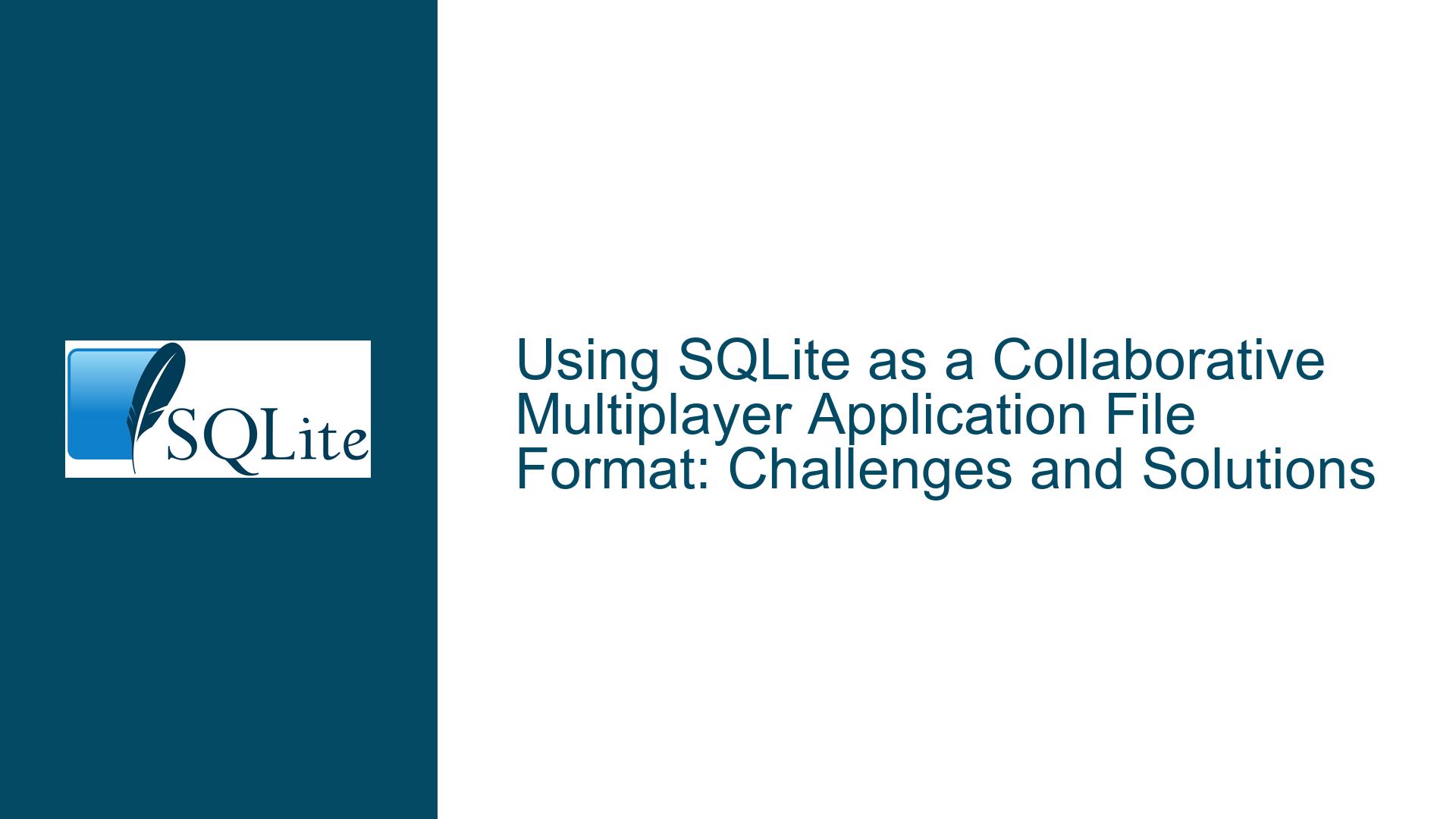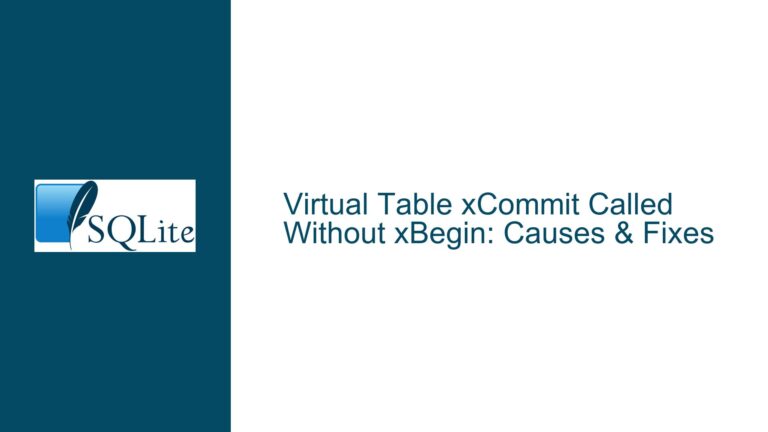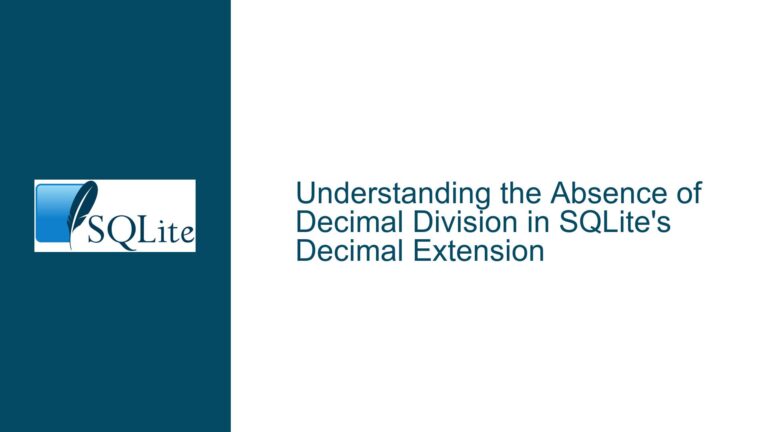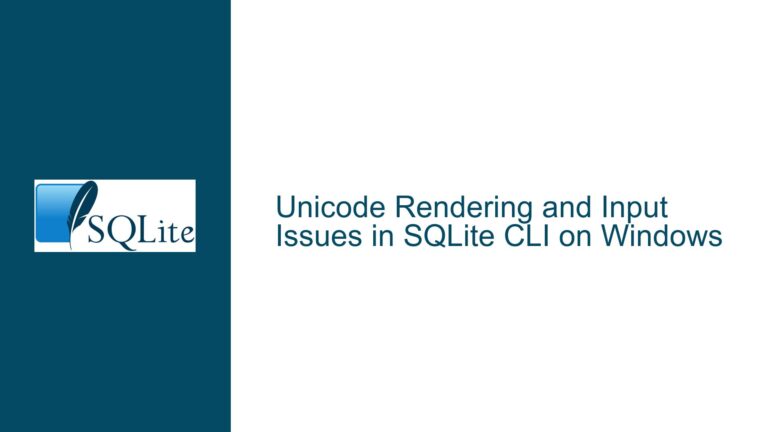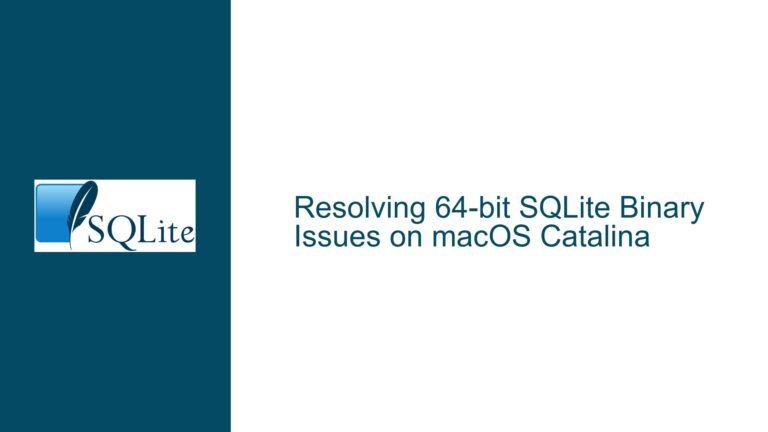Using SQLite as a Collaborative Multiplayer Application File Format: Challenges and Solutions
SQLite as a Collaborative Multiplayer Application File Format: Challenges and Solutions
Issue Overview
The core issue revolves around leveraging SQLite as a collaborative and multiplayer application file format, akin to the real-time collaborative editing features found in applications like Google Docs or Figma. The primary challenge is enabling multiple users to concurrently edit the same SQLite database file while ensuring that changes are synchronized in real-time and conflicts are resolved automatically. This is a non-trivial task due to SQLite’s design as a lightweight, serverless database engine that traditionally operates in a single-writer, multiple-reader (SWMR) mode. The SWMR model inherently limits concurrent write operations, making real-time collaboration difficult without significant modifications or extensions to SQLite’s core functionality.
The discussion highlights an attempt to address this challenge through a custom SQLite loadable extension named cr-sqlite. This extension aims to replicate the functionality of SQLite’s Session Extension but with added capabilities for real-time conflict resolution and synchronization. The extension allows changes from one SQLite database to be applied to another, enabling a form of real-time collaboration. However, the implementation of such a system introduces several technical complexities, including conflict resolution strategies, data consistency guarantees, and performance considerations under high concurrency.
The overarching goal is to transform SQLite into a viable backend for collaborative applications, where multiple users can simultaneously edit a shared database file and see each other’s changes in real-time. This requires addressing several key challenges, such as handling concurrent writes, ensuring data integrity, and providing a seamless user experience. The cr-sqlite extension represents a significant step towards this goal, but it also raises questions about scalability, reliability, and the broader applicability of SQLite in collaborative environments.
Possible Causes
The challenges associated with using SQLite as a collaborative multiplayer application file format stem from several underlying causes. First and foremost is SQLite’s single-writer, multiple-reader (SWMR) concurrency model. In this model, only one writer can modify the database at any given time, while multiple readers can access the database concurrently. This design is well-suited for many lightweight applications but becomes a bottleneck in collaborative scenarios where multiple users need to write to the database simultaneously. The SWMR model inherently limits the ability to support real-time collaborative editing, as it requires serializing write operations, which can lead to delays and conflicts.
Another significant cause is the lack of built-in support for real-time conflict resolution in SQLite. In a collaborative environment, conflicts are inevitable when multiple users attempt to modify the same data concurrently. Traditional conflict resolution mechanisms, such as last-write-wins or manual conflict resolution, are often insufficient for real-time collaborative applications, where users expect immediate feedback and seamless integration of changes. The absence of a robust conflict resolution framework in SQLite necessitates the development of custom solutions, such as the cr-sqlite extension, which introduces additional complexity and potential points of failure.
The third cause is the performance overhead associated with real-time synchronization and conflict resolution. In a collaborative application, every change made by a user must be propagated to all other users in real-time, requiring efficient data synchronization mechanisms. This can be particularly challenging in SQLite, which is designed for local storage and does not natively support network-based synchronization. The cr-sqlite extension attempts to address this by providing a mechanism for applying changes from one database to another, but this approach introduces performance considerations, such as latency, bandwidth usage, and the computational cost of conflict resolution.
Finally, the lack of a standardized protocol or API for collaborative editing in SQLite complicates the development of collaborative applications. Unlike specialized collaborative platforms like Google Docs or Figma, which provide built-in support for real-time collaboration, SQLite requires custom extensions and additional infrastructure to achieve similar functionality. This increases the development effort and introduces potential compatibility issues, as different extensions may implement conflicting or incompatible approaches to collaboration.
Troubleshooting Steps, Solutions & Fixes
To address the challenges of using SQLite as a collaborative multiplayer application file format, several troubleshooting steps, solutions, and fixes can be implemented. The first step is to evaluate the suitability of SQLite for the specific collaborative application in question. While SQLite is a powerful and versatile database engine, it may not be the best choice for all collaborative scenarios, particularly those requiring high levels of concurrency or real-time synchronization. In such cases, alternative database systems with built-in support for collaboration, such as Firebase or CouchDB, may be more appropriate.
For applications where SQLite is deemed suitable, the next step is to implement a custom solution for real-time collaboration, such as the cr-sqlite extension. This involves several key components, including conflict resolution strategies, data synchronization mechanisms, and performance optimization techniques. The cr-sqlite extension provides a starting point for implementing these components, but additional customization may be required to meet the specific needs of the application.
One critical aspect of implementing real-time collaboration in SQLite is conflict resolution. The cr-sqlite extension includes automatic conflict resolution, but the specific strategy used may need to be tailored to the application’s requirements. Common conflict resolution strategies include last-write-wins, where the most recent change takes precedence; operational transformation, which transforms conflicting operations to preserve consistency; and merge-based resolution, which combines conflicting changes into a single, unified result. The choice of conflict resolution strategy depends on factors such as the nature of the data, the frequency of conflicts, and the desired user experience.
Another important consideration is data synchronization. In a collaborative application, changes made by one user must be propagated to all other users in real-time. This requires an efficient and reliable synchronization mechanism, which can be implemented using a combination of SQLite’s Session Extension and custom synchronization logic. The Session Extension allows changes to be captured and applied between databases, but additional infrastructure is needed to handle network communication, manage connections, and ensure data consistency. This may involve integrating SQLite with a messaging system, such as WebSockets or MQTT, to facilitate real-time communication between clients.
Performance optimization is also crucial for ensuring a smooth user experience in a collaborative SQLite application. This includes minimizing latency, reducing bandwidth usage, and optimizing the computational cost of conflict resolution. Techniques for performance optimization include batching changes to reduce the number of synchronization operations, compressing data to reduce bandwidth usage, and using efficient algorithms for conflict resolution. Additionally, it may be necessary to partition the database or use sharding techniques to distribute the load across multiple SQLite instances, particularly in applications with a large number of concurrent users.
Finally, it is important to establish a standardized protocol or API for collaborative editing in SQLite. This can help ensure compatibility between different extensions and simplify the development of collaborative applications. The cr-sqlite extension provides a foundation for such a protocol, but further standardization efforts may be needed to establish best practices and promote interoperability. This could involve collaborating with the SQLite community to develop a formal specification for collaborative editing, as well as creating reference implementations and documentation to support developers in adopting the protocol.
In conclusion, while SQLite presents several challenges for use as a collaborative multiplayer application file format, these challenges can be addressed through a combination of custom extensions, conflict resolution strategies, data synchronization mechanisms, and performance optimization techniques. The cr-sqlite extension represents a significant step towards enabling real-time collaboration in SQLite, but further development and standardization efforts are needed to fully realize the potential of SQLite in collaborative applications. By carefully evaluating the suitability of SQLite for specific use cases and implementing tailored solutions, developers can leverage SQLite’s strengths to create powerful and efficient collaborative applications.
